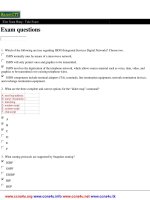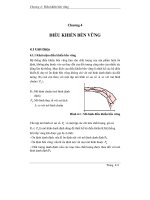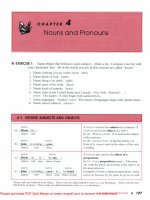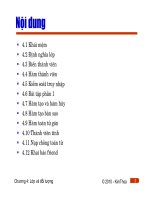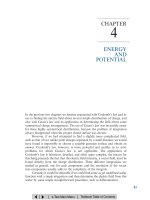Chapter4 b
Bạn đang xem bản rút gọn của tài liệu. Xem và tải ngay bản đầy đủ của tài liệu tại đây (768.89 KB, 36 trang )
IP datagram format
IP protocol version
number
header length
(bytes)
“type” of data
max number
remaining hops
(decremented at
each router)
upper layer protocol
to deliver payload to
32 bits
ver head.
len
type of
service
16-bit identifier
upper
time to
layer
live
flgs
length
fragment
offset
Internet
checksum
total datagram
length (bytes)
for
fragmentation/
reassembly
32 bit source IP address
32 bit destination IP address
Options (if any)
data
(variable length,
typically a TCP
or UDP segment)
E.g. timestamp,
record route
taken, pecify
list of routers
to visit.
4: Network Layer
4b-1
IP Fragmentation & Reassembly
network links have MTU (max.transfer
size) - largest possible link-level frame.
different link types, different
MTUs
large IP datagram divided
(“fragmented”) within net
one datagram becomes several
datagrams
“reassembled” only at final
destination
IP header bits used to identify,
order related fragments
fragmentation:
in: one large datagram
out: 3 smaller datagrams
reassembly
4: Network Layer
4b-2
IP Fragmentation and Reassembly
length ID
=4000 =x
fragflag
=0
offset
=0
One large datagram becomes
several smaller datagrams
length
=1500
ID
=x
fragflag
=1
offset
=0
length
=1500
ID
=x
fragflag
=1
offset
=1480
length ID
=1040 =x
fragflag
=0
offset
=2960
4: Network Layer
4b-3
ICMP: Internet Control Message Protocol
used by hosts, routers, gateways to
communication network-level
information
error reporting: unreachable host,
network, port, protocol
echo request/reply (used by ping)
network-layer “above” IP:
ICMP msgs carried in IP
datagrams
ICMP message: type, code plus first 8
bytes of IP datagram causing error
Type
0
3
3
3
3
3
3
4
Code
0
0
1
2
3
6
7
0
8
9
10
11
12
0
0
0
0
0
description
echo reply (ping)
dest. network unreachable
dest host unreachable
dest protocol unreachable
dest port unreachable
dest network unknown
dest host unknown
source quench (congestion
control - not used)
echo request (ping)
route advertisement
router discovery
TTL expired
bad IP header
4: Network Layer
4b-4
Routing in the Internet
The Global Internet consists of Autonomous Systems (AS)
interconnected with each other:
Stub AS: small corporation
Multihomed AS: large corporation (no transit)
Transit AS: provider
Two-level routing:
Intra-AS: administrator is responsible for choice
Inter-AS: unique standard
4: Network Layer
4b-5
Internet AS Hierarchy
Intra-AS border (exterior gateway) routers
Inter-AS interior (gateway) routers
4: Network Layer
4b-6
Intra-AS Routing
Also known as Interior Gateway Protocols (IGP)
Most common IGPs:
RIP: Routing Information Protocol
OSPF: Open Shortest Path First
IGRP: Interior Gateway Routing Protocol (Cisco propr.)
4: Network Layer
4b-7
RIP ( Routing Information Protocol)
Distance vector algorithm
Included in BSD-UNIX Distribution in 1982
Distance metric: # of hops (max = 15 hops)
Can you guess why?
Distance vectors: exchanged every 30 sec via Response Message (also
called advertisement)
Each advertisement: route to up to 25 destination nets
4: Network Layer
4b-8
RIP (Routing Information Protocol)
z
w
A
x
D
B
y
C
Destination Network
w
y
z
x
….
Next Router
A
B
B
--
Num. of hops to dest.
….
2
2
7
1
....
Routing table in D
4: Network Layer
4b-9
RIP: Link Failure and Recovery
If no advertisement heard after 180 sec --> neighbor/link declared dead
routes via neighbor invalidated
new advertisements sent to neighbors
neighbors in turn send out new advertisements (if tables changed)
link failure info quickly propagates to entire net
poison reverse used to prevent ping-pong loops (infinite distance =
16 hops)
4: Network Layer 4b-10
RIP Table processing
RIP routing tables managed by application-level process called
route-d (daemon)
advertisements sent in UDP packets, periodically repeated
4: Network Layer 4b-11
RIP Table example (continued)
Router: giroflee.eurocom.fr
Destination
-------------------127.0.0.1
192.168.2.
193.55.114.
192.168.3.
224.0.0.0
default
Gateway
Flags Ref
Use
Interface
-------------------- ----- ----- ------ --------127.0.0.1
UH
0 26492 lo0
192.168.2.5
U
2
13 fa0
193.55.114.6
U
3 58503 le0
192.168.3.5
U
2
25 qaa0
193.55.114.6
U
3
0 le0
193.55.114.129
UG
0 143454
Three attached class C networks (LANs)
Router only knows routes to attached LANs
Default router used to “go up”
Route multicast address: 224.0.0.0
Loopback interface (for debugging)
4: Network Layer 4b-12
OSPF (Open Shortest Path First)
“open”: publicly available
Uses Link State algorithm
LS packet dissemination
Topology map at each node
Route computation using Dijkstra’s algorithm
OSPF advertisement carries one entry per neighbor router
Advertisements disseminated to entire AS (via flooding)
4: Network Layer 4b-13
OSPF “advanced” features (not in RIP)
Security: all OSPF messages authenticated (to prevent malicious
intrusion); TCP connections used
Multiple same-cost paths allowed (only one path in RIP)
For each link, multiple cost metrics for different TOS (eg, satellite link
cost set “low” for best effort; high for real time)
Integrated uni- and multicast support:
Multicast OSPF (MOSPF) uses same topology data base as OSPF
Hierarchical OSPF in large domains.
4: Network Layer 4b-14
Hierarchical OSPF
4: Network Layer 4b-15
Hierarchical OSPF
Two-level hierarchy: local area, backbone.
Link-state advertisements only in area
each nodes has detailed area topology; only know direction (shortest
path) to nets in other areas.
Area border routers: “summarize” distances to nets in own area,
advertise to other Area Border routers.
Backbone routers: run OSPF routing limited to backbone.
Boundary routers: connect to other ASs.
4: Network Layer 4b-16
IGRP (Interior Gateway Routing Protocol)
CISCO proprietary; successor of RIP (mid 80s)
Distance Vector, like RIP
several cost metrics (delay, bandwidth, reliability, load etc)
uses TCP to exchange routing updates
Loop-free routing via Distributed Updating Alg. (DUAL) based
on diffused computation
4: Network Layer 4b-17
Inter-AS routing
4: Network Layer 4b-18
Internet inter-AS routing: BGP
BGP (Border Gateway Protocol): the de facto standard
Path Vector protocol:
similar to Distance Vector protocol
each Border Gateway broadcast to neighbors (peers)
(I.e, sequence of ASs) to destination
E.g., Gateway X may send its path to dest. Z:
entire path
Path (X,Z) = X,Y1,Y2,Y3,…,Z
4: Network Layer 4b-19
Internet inter-AS routing: BGP
Suppose: gateway X send its path to peer gateway W
W may or may not select path offered by X
cost, policy (don’t route via competitors AS), loop prevention reasons .
If W selects path advertised by X, then:
Path (W,Z) = w, Path (X,Z)
Note: X can control incoming traffic by controling it route advertisements to peers:
e.g., don’t want to route traffic to Z -> don’t advertise any routes to Z
4: Network Layer 4b-20
